English Bulldog Colors: A Comprehensive Guide (2024)

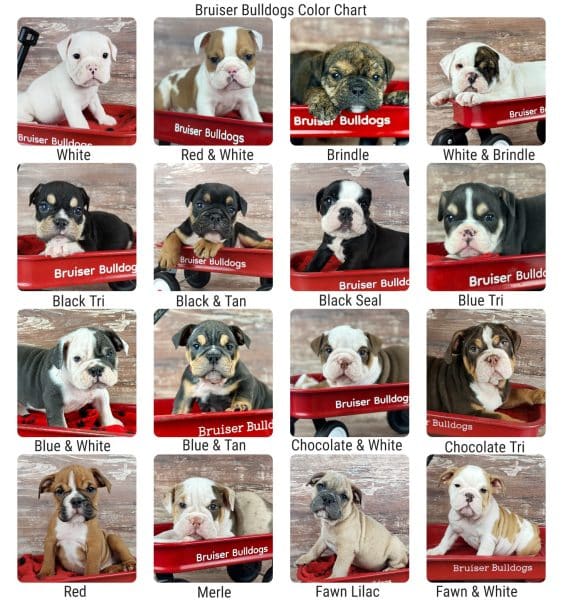
English Bulldog Colors: A Comprehensive Guide (2024)
History of Bulldog Coat Colors
English Bulldog coat colors can historically be broken down into two camps: standard and non-standard or rare colored bulldogs. For many decades the standard group of colors dominated English Bulldogs. These colors were promoted by AKC show clubs as “desirable” and became the preferred choice by most bulldog owners. In many countries standard colors still make up the vast majority of bulldogs that are produced. As the of influence of show clubs declined, rare colors started to gain popularity in the early 2000’s. Every couple of years a new color would be “discovered” and would quickly become the next hot ticket bulldog to purchase. This type of consumer mentality was met with disdain by traditional bulldog clubs (ironic because show club’s breed standards are incredibly unhealthy as well) and rare color breeding in general has been labeled as “unhealthy” because the focus is often on producing a certain color and not health or quality.
Standard Color Bulldogs
(Red, White, Fawn, and Brindle (color pattern))
History of the Standard Coats: Fawn, White, Red, Brindle
The fawn, red, and white Bulldog coats are typically classified as standard or traditionally accepted coat colors within Bulldog Clubs and the AKC. Historically, the fawn coat color was quite possibly considered undesirable during the early formation of the English Bulldog breed. In the early 1800’s Bulldogs were primarily used for jobs connected to bull baiting and bear hunting in Europe. The dog was designed low to the ground and its behavior was quite tough and aggressive. As the practices of bull baiting and bear hunting were eventually banned, the Bulldog’s popularity and function waned. Having become obsolete in the job it was designed for, bulldog enthusiast, drawn to the loyalty and toughness of the breed, quickly pivoted and began breeding for a less aggressive dog with the intention of creating a companion dog. Breed standards were drawn with the intention of reducing the aggressiveness of the breed. At the time, the tan and black colored bulldogs were considered more aggressive than other colored bulldogs, drawing their ancestry from fighting dogs originating throughout Spain and down into the late Roman Empire. For a short period, the fawn or tan bulldogs were considered undesirable and were eliminated from the breed standard only to then be reinstated at a later time. In contrast, the early bulldog bloodlines were filled with predominantly white and red colored coats as these types of bulldogs were viewed as calmer or less aggressive bulldogs. Overtime, all three colors: red, fawn, and white made up the traditional colors of English Bulldog kennel clubs across Europe and later on in the United States.
Fawn Coat Color
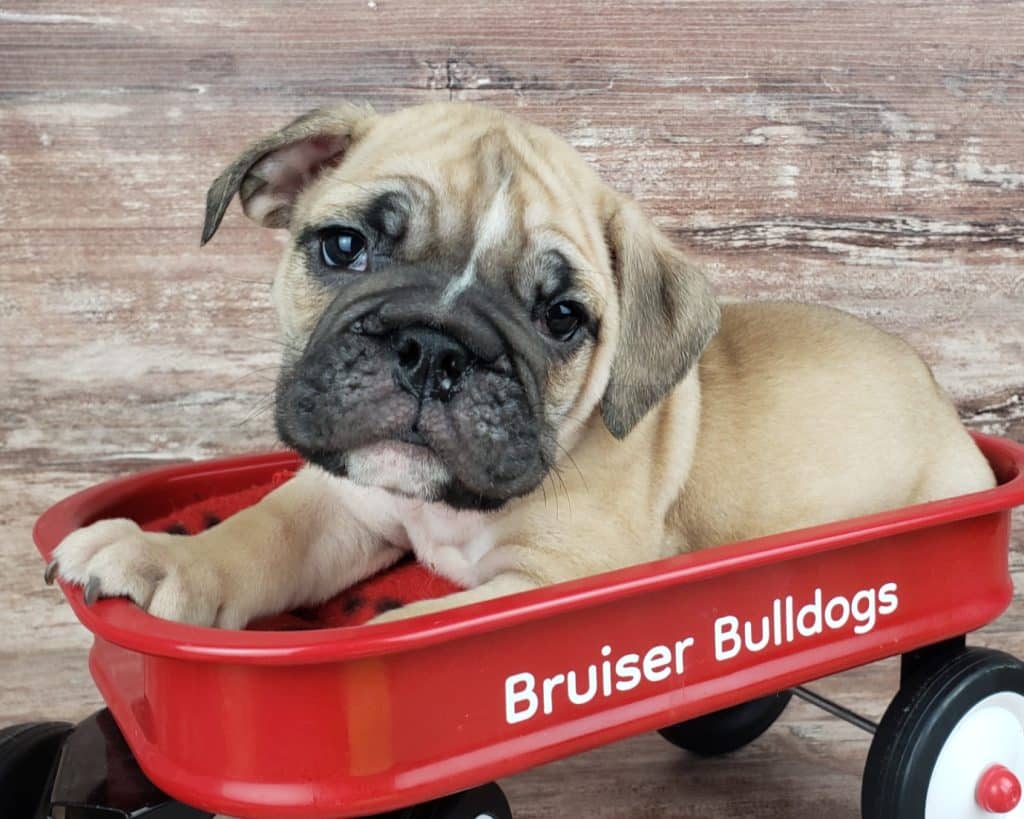
Example of Fawn Bulldog Puppy
Bruiser Bulldog’s Take on Fawn Coats
We personally love the look of a fawn bulldog. Fawn English Bulldog Puppies for Sale appear to be slightly more recessive than other standard colors such as white or brindle so it is always fun when we have a litter of fawn pups. Obviously, the historical opinions of aggressiveness are not relevant 150 years later. We have found some of our sweetest most even tempered bulldogs to be from the fawn color.
Check out our Fawn English Bulldog Color Guide – Click Here
Red Coat Color
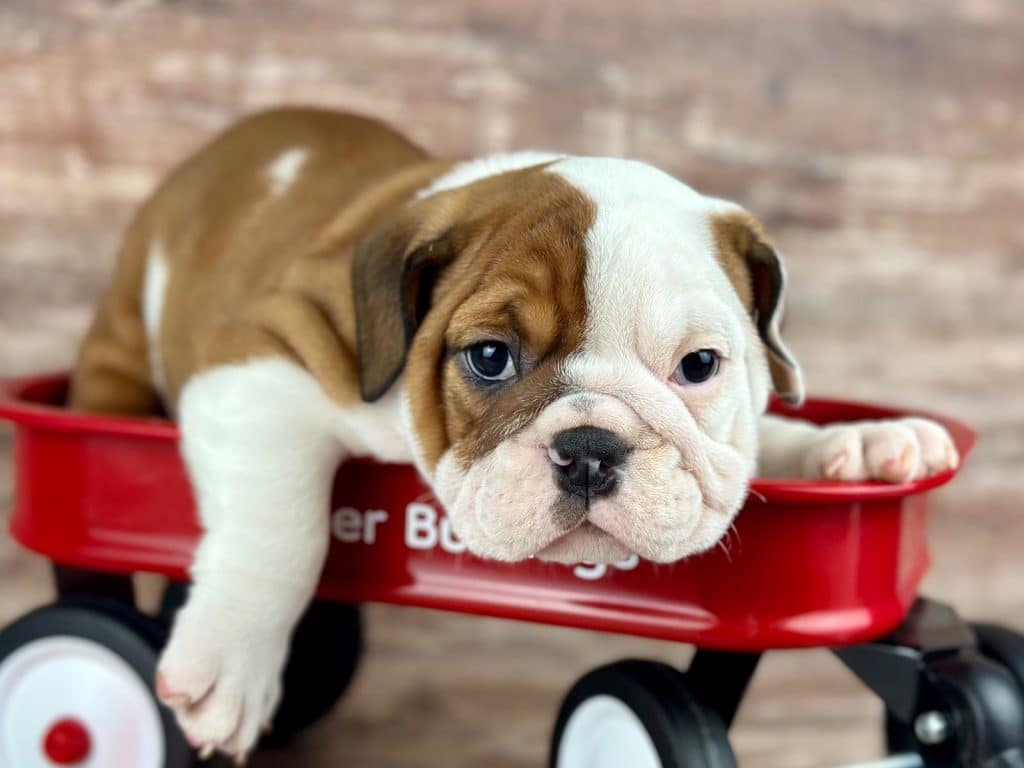
Example of a Red Bulldog Puppy
Bruiser Bulldog’s Take on Red Coats
Over the years, it appears that the red coat has become one of the more dominant colors thrown by our Bruiser Bulldog bloodlines. Red English Bulldog Puppies for Sale appear to be slightly more dominant than other standard colors such as white or fawn. We have typically found the red color to be extremely low maintenance, suffering less frequently from skin allergies and irritants. We have also noticed that there are often different hues of the red coat. Some of our red puppies have extremely dark, rich coats of red that often can be traced from parents to their offspring. If we breed a male and female, both with darker red coats, almost certainly we can expect puppies of the same nature. In contrast, we also commonly see red coats that are lighter with a blend of fawn. It appears that the lighter red often is associated with a finer coat texter that is sometimes softer.
Check out our Red English Bulldog Color Guide – Click Here
White Coat Color
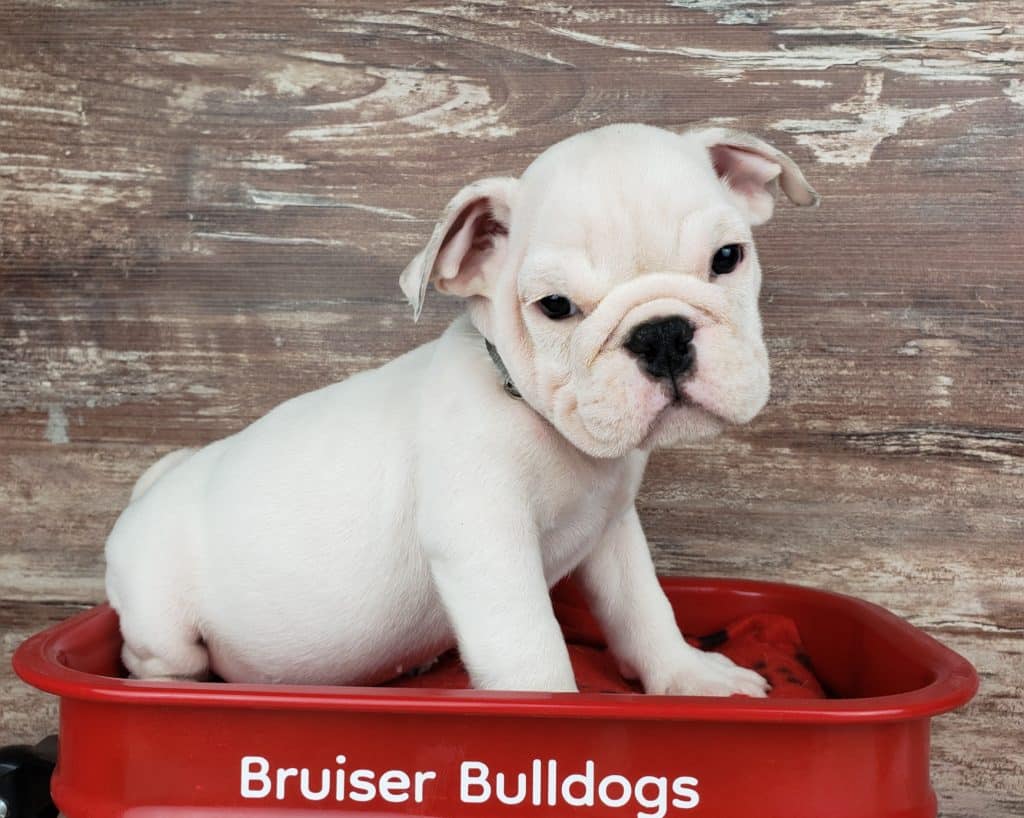
Example of a White Bulldog Puppy
Bruiser Bulldog’s Take on White Coats
We absolutely love our white bulldogs! Some of the original Bruiser Bulldogs that we started breeding with were from white bloodlines. We love the history of the white bulldog and its place as one of the original coat colors of the breed. Certainly the white bulldog will always have its place as the foundation of the bulldog breed and should be recognized by that importance. With the current craze of rare colored bulldogs it appears that the classic white bulldog is becoming more uncommon simply because of breeder selection favoring rare colors. Ironically, the white coat is now often more uncommon to see than the traditional “rare colors” such as black tri or chocolate. In our minds this increases the value and appeal of white bulldogs and elevates its status as a classic. While white English Bulldog Puppies for sale are beautiful we are very careful with our genetic selection amongst this coat type. We will intentionally avoid “all white” parents as occasionally deafness is associated with pure white and especially female bulldogs. All of our white bulldogs undergo extensive auditory tests to ensure they are of perfect hearing before they go to their new homes. Often our goal is to achieve the best pairing of a predominantly white bulldog with some patches or piebald coloring in the mix. This combination allows for the classic white bulldog look but ensures that deafness is not a problem. As long as there is some coloration within the coat color, the risk of deafness is the same as any other color combination among the English Bulldog spectrum.
White English Bulldog Color Guide – Click Here
Brindle Coat Color
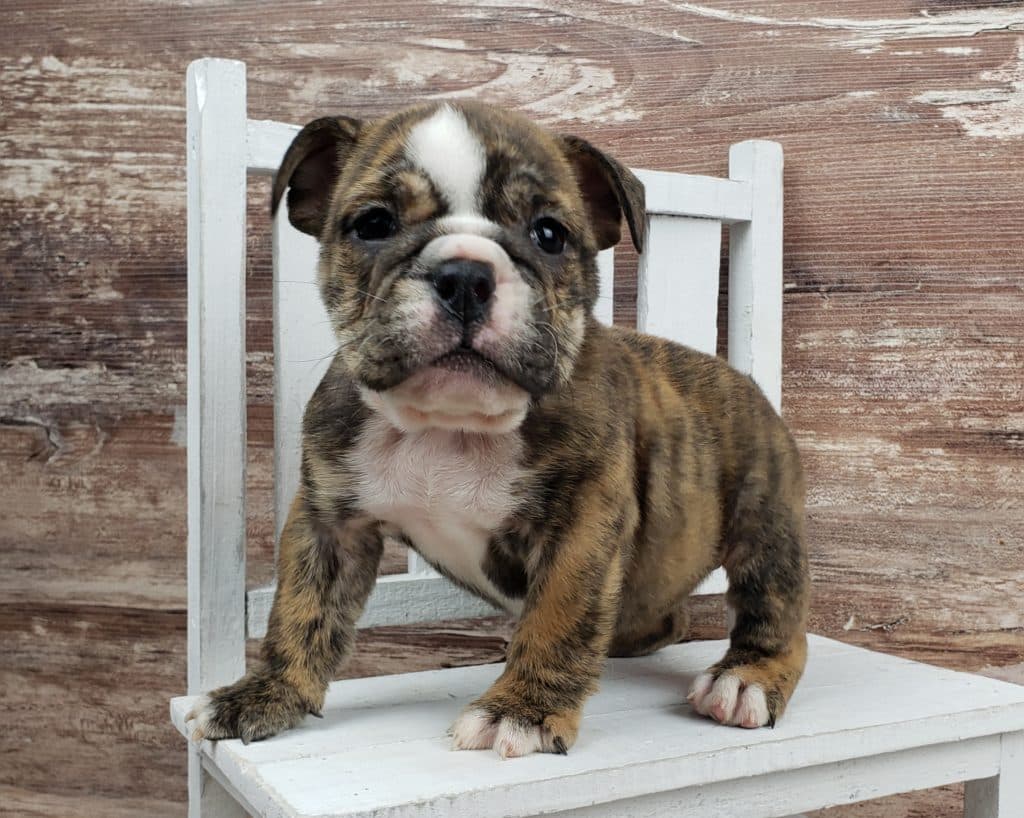
Example of a Brindle Bulldog Puppy
Bruiser Bulldog’s Take on Brindle Coats
The Brindle coat is a traditional favorite here at Bruiser Bulldogs. We believe brindle coats are one of the lower maintenance coats amongst English Bulldog coat colors. The first positive characteristic of brindle is the lack of tear stains. Typically a true brindle will have extensive brindle coloration around it’s facial features. Darker hues often do better covering tear stains and will allow the bulldog to appear clean and well put together. The bulldog will require less maintenance and focus on tear stain issues. The second quality we love about Brindle English Bulldog puppies for sale is absence of allergies. We have found brindle bulldogs to be extremely healthy, rarely suffering from skin allergies that occasionally show up in other coat colors.
Brindle English Bulldog Color Guide – Click Here
Rare Color Bulldogs
(Black, Blue, Lilac, Chocolate, Merle, Tri)
Bruiser Bulldog’s View of Rare Colors
We try our best not to villainize ideas or breeding practices as simply “good” or “bad” but would rather look at the actual science and genetics of the practice before labeling. Rare color breeding in theory certainly has its problems. Often breeders become solely fixated on producing a single type of rare color. They only select males and females that carry specific recessive colors to uniformly produced rare colored bulldog puppies. We agree that many times quality and health of the bulldog become secondary when rare color breeding becomes the sole focus of a breeding program (which many times it is).
The interesting contrast to this problem is that many rare color bulldogs are incredibly healthy. When rare colors first started popping up among bulldog breeders, we took a very hard stance against the practice. The consumer mentality simply felt irresponsible and disaster seemed inevitable. Over the years, as the rare bulldog scene has become more commonplace, we have noticed that rare bulldogs often represent the very type of bulldog that we breed for. Rare bulldogs often breath better and have a lighter wrinkle set compared to standard colored bulldogs. Ironically, the reason for this health characteristic might be attributed to the Kennel Club’s disdain for rare colors. Because rare colors are rejected by Bulldog show clubs, rare colored bulldogs have not been subject to the unhealthy show standards required to win in the show ring.
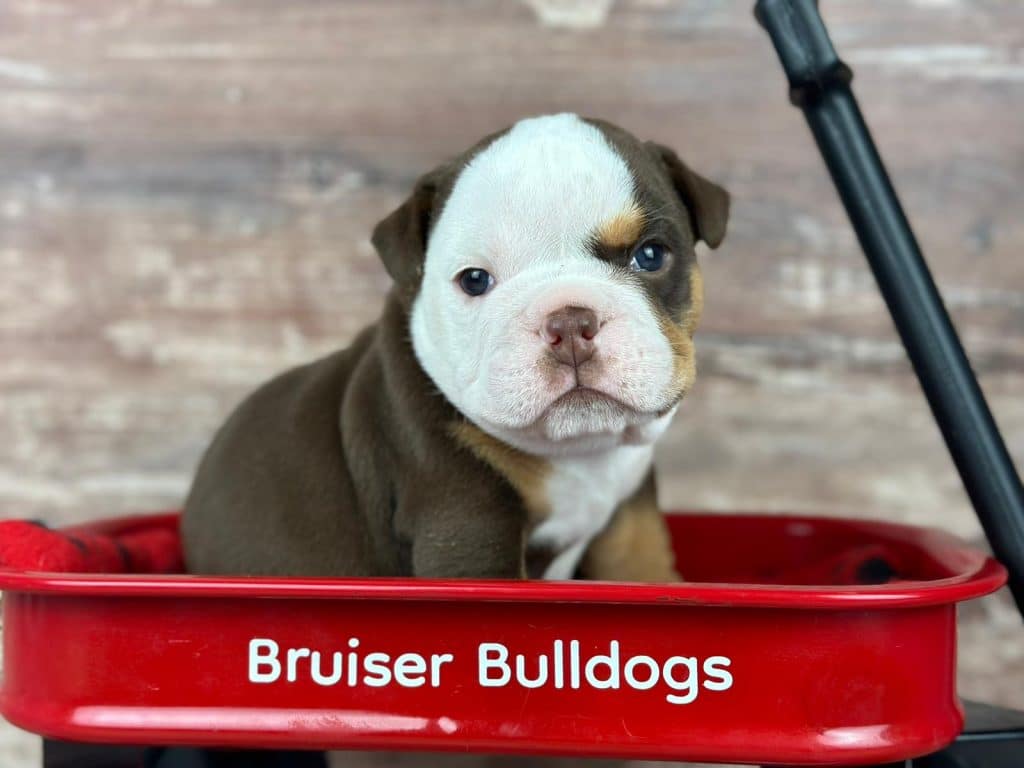
Example of Chocolate Tri Bulldog Puppy
Origination Theory
An additional positive is the origination of rare colors in the first place. Have you ever wondered where rare colors came from? It is most likely that these different types of coats were achieved by “outcrossing” different dog breeds into the English Bulldog breed. We know, that for example the color “Merle” is common place in dogs like Australian Shepherds and Border Collies. It doesn’t take much imagination to understand that the influx of rare colors were most likely injected from other dog breeds. The AKC requires each dog breed to be genetically 7/8ths pure. To achieve this requirement, rare color breeders probably did an “outcross” breeding to pull in new color and then did generational breedings until the offspring were again considered pure enough to be accepted into the AKC requirements. While this process was certainly dishonest, the eventual outcome is that we now have bulldogs that have been injected with new, healthier DNA from other distant breeds. We know from canine studies, the inbreeding coefficient or how closely the entire breed is related to one another often dictates how realistically healthy a dog breed can be. New DNA allows responsible breeders like ourselves to tap into and correct existing health issues within the breed. We believe that while the process of creating rare bulldogs was consumer driven and irresponsible, the end result was actually a net positive for the Bulldog breed in general.
At Bruiser Bulldogs we have intentionally developed a “color blind” view of rare colors. We never want to be sucked into the trap of breeding for rare colors and ignore health but we do not want to be scared of a bulldog if it is healthy simply based on a stereotype. We want to breed healthy bulldogs regardless of their color type. If you look at our adult bulldogs at present day, about 1/3 have some type of rare color characteristic. More importantly, all of these bulldogs have been selected because of the health characteristics they offer our bloodlines.
Black Coat Color
Black Color Basics
There are several different variations of the black color. The black color can be expressed a variety of ways which include: black and tan, black tri, black seal, black merle, black platinum, and black brindle. Black Bulldogs are often recognized as the most common of all rare colored bulldogs. We believe the black color should be shiny and appear to be black in color against black objects or in the sun. This is to ensure the color produced is true black as opposed to black seal which displays a different undertone to the black coat. With all black bulldogs, the nose, footpads, and eyeliner are always a true black. Black is often considered the most basic building block from which other rare English Bulldog colors are produced.
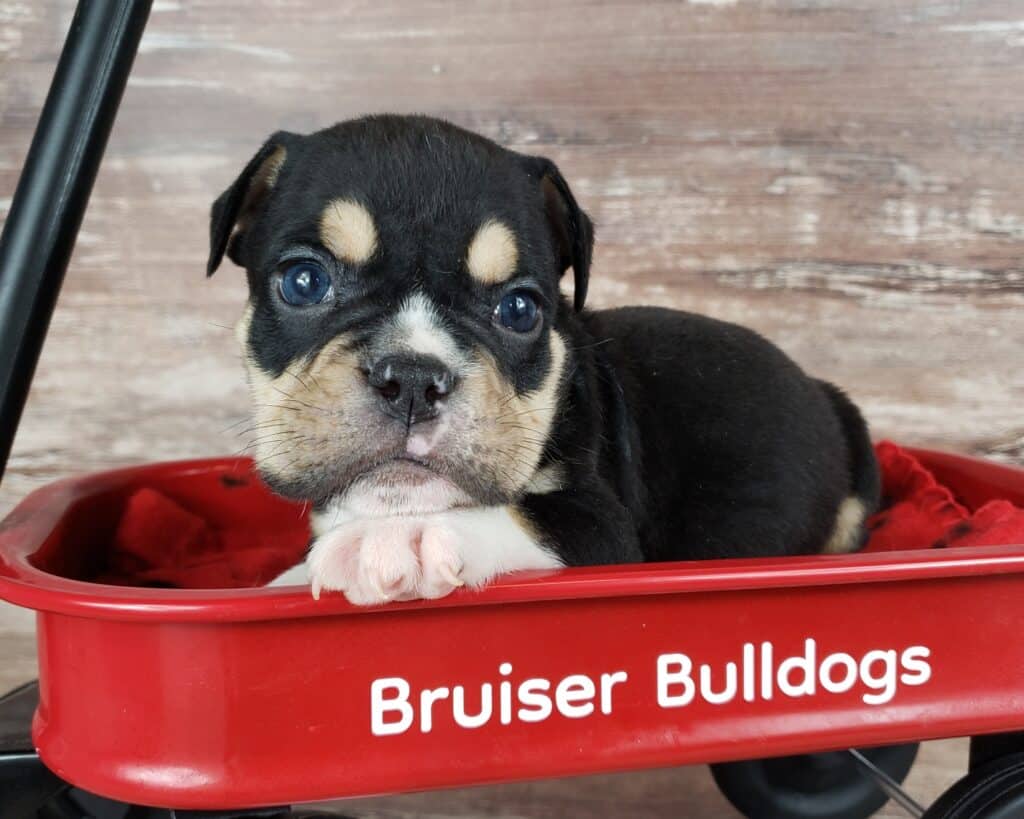
Example of a Black Tri English Bulldog Puppy
Black Tri Puppies
One of our favorite types of Black English Bulldog Puppies for sale are the black tri color. Black tri’s can be described as a color pattern where the tan points are typically on the eyebrows, cheeks, front shoulders (right above the chest area between the legs), around the tail, and partial on both front and back legs. Tan points will typically not show up if the bulldog carries white color patterns where the points would normally be. Tan points can also be hidden by other genes, such as the SEAL gene, as it is higher on the hierarchy of genes.
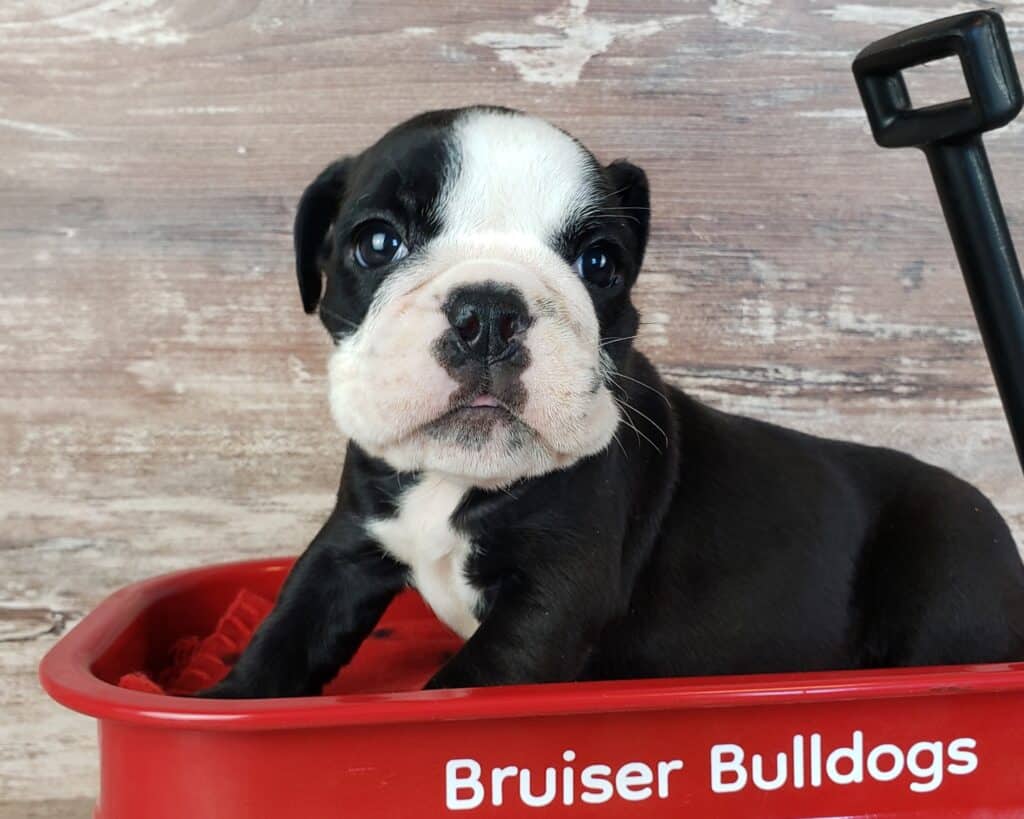
Example of a Black Seal English Bulldog Puppy
Bruiser Bulldog’s take on Black Coats
We know that Black is the most common rare color and is often the base to create other rare color variations. Because we do not travel down the “rare color” road very far, black bulldogs are a color type we see often. The Black color shows up often even when one is not truly breeding to produce a specific color. Black tri’s are one of our favorite colors and are always a highlight when one of our litters produces this color type. Black tri’s are unique because of the tan eyebrows that often compliment a bulldog puppy’s facial structure. We always have a couple black bulldog parents that will occasionally produce black puppies. Our personal experience with the black coat color has been positive. It appears skin allergies and other genetic traits like deafness that occasionally accompany specific coat colors are not a problem within black genetics. If you are interested in a Black English Bulldog please let us know as it is very possible we will have upcoming litters with this color type and the knowledge that our priorities lie within healthy breeding practices and not necessarily rare color production.
Black English Bulldog Color Guide – Click Here
Chocolate Coat Color
Chocolate Color Basics
Genotype for Chocolate Gene: [bb]
There are several different variations of the chocolate color. The chocolate color can be expressed a variety of ways which include: light chocolate, chocolate sable, dark chocolate, and chocolate tri. One of the most common chocolate color hues is light chocolate which is often an most accurately described as an orange color. Often light chocolate is a full body coat and does not carry the “tri” color pattern seen in dark chocolate. dark chocolate is often described a Hershey Chocolate color and is often accompanied by lighter “tri” markings above the eyebrows, chest, and lower legs (similar to a Rottweiler marking). While chocolate color hues can vary slightly the liver color nose confirms a true Chocolate English Bulldog. A black nose means the Bulldog is not a true chocolate and should be described more accurately as a red coat.
Explanation of the Chocolate Color
Most dog breeders do not realize that the chocolate color in bulldogs is actually a diluted black coat. What this means is the presence of the chocolate gene structure (bb) or (Brown/Liver) dilutes a black coat to brown. The chocolate gene is actually a dilution gene and not an actual color gene at all. For example, a dark chocolate bulldog puppy would first have to carry the black color gene as a base as well the the chocolate (bb) to dilute the color down. In addition to the liver nose, DNA proof of a chocolate puppy will reveal “bb” alleles. Parents of a chocolate offspring will contribute one of their dilution genes to their offspring: either the brown (b) gene or a non-brown (B) gene. chocolate parents (bb) will produce only a brown (b) gene and non-brown parents (BB) will only contribute a non-brown gene (B). The eyes of Chocolate English Bulldog puppies for sale are often blue, gray, or light gold.
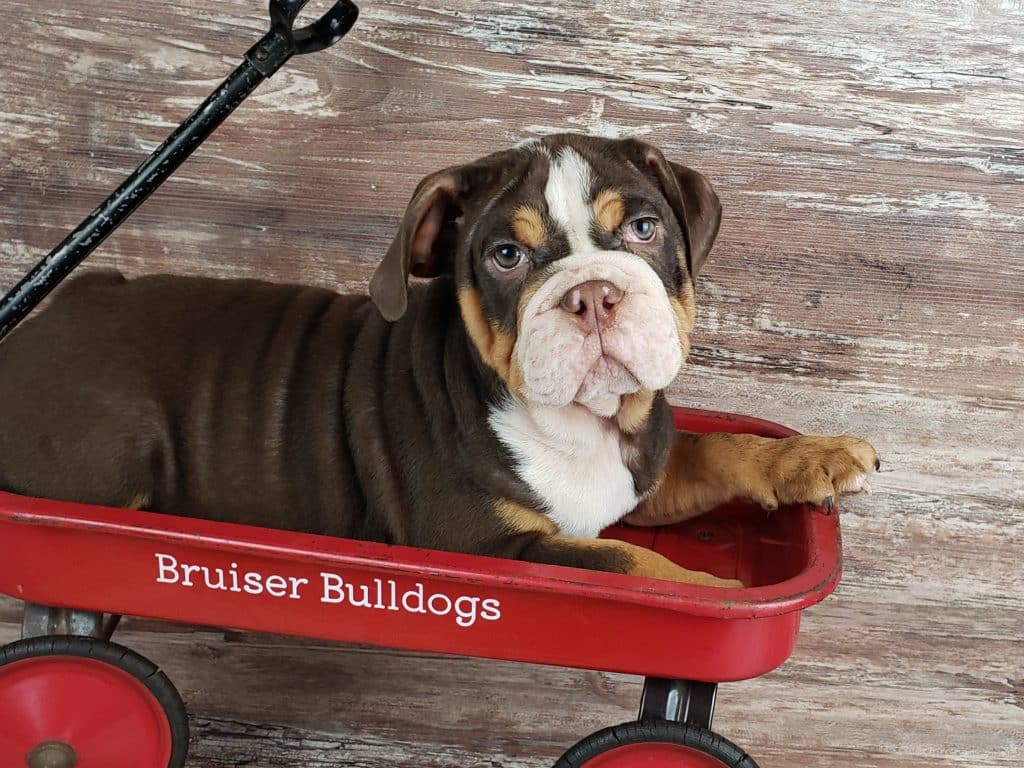
Example of a Dark Chocolate Tri Bulldog Puppy
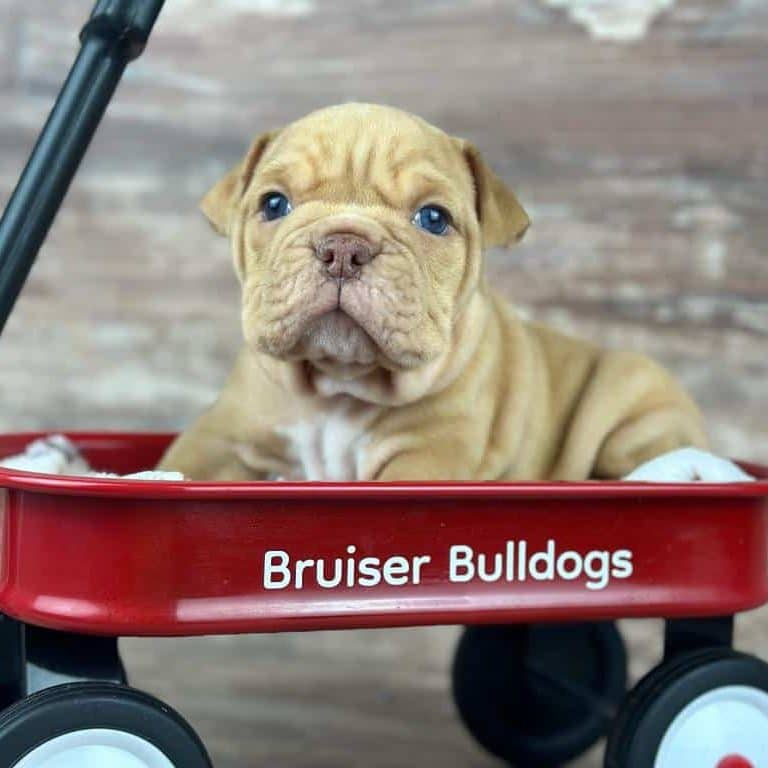
Example of a Light Chocolate Bulldog Puppy
Bruiser Bulldog’s Take on Chocolate Coats
Chocolate is the second most common rare English Bulldog colors and has historically been a color type that we have produced here at Bruiser Bulldogs. While the lighter chocolate color is much more common amongst our bloodlines, occasionally we have had a dark chocolate and on an even rarer occasion we have had a couple dark chocolate tri’s. As stated previously, our goal is to understand the genetics at hand that produce rare colors. We desire to take a very neutral approach to rare colors – neither being afraid nor intentionally breeding for rare color. With that said, we certainly love the look of the chocolate color and have had several chocolate studs over the years which have proven to be extremely healthy. The Chocolate English Bulldog puppies we have produced have not stood out as unhealthy, rather we have seen our Bruiser Bulldog’s health improve by utilizing healthy chocolate genetics. We would certainly recommend our Bruiser Bulldog chocolate puppies to anyone that appreciates the color.
Chocolate English Bulldog Color Guide – Click Here
Blue Coat Color
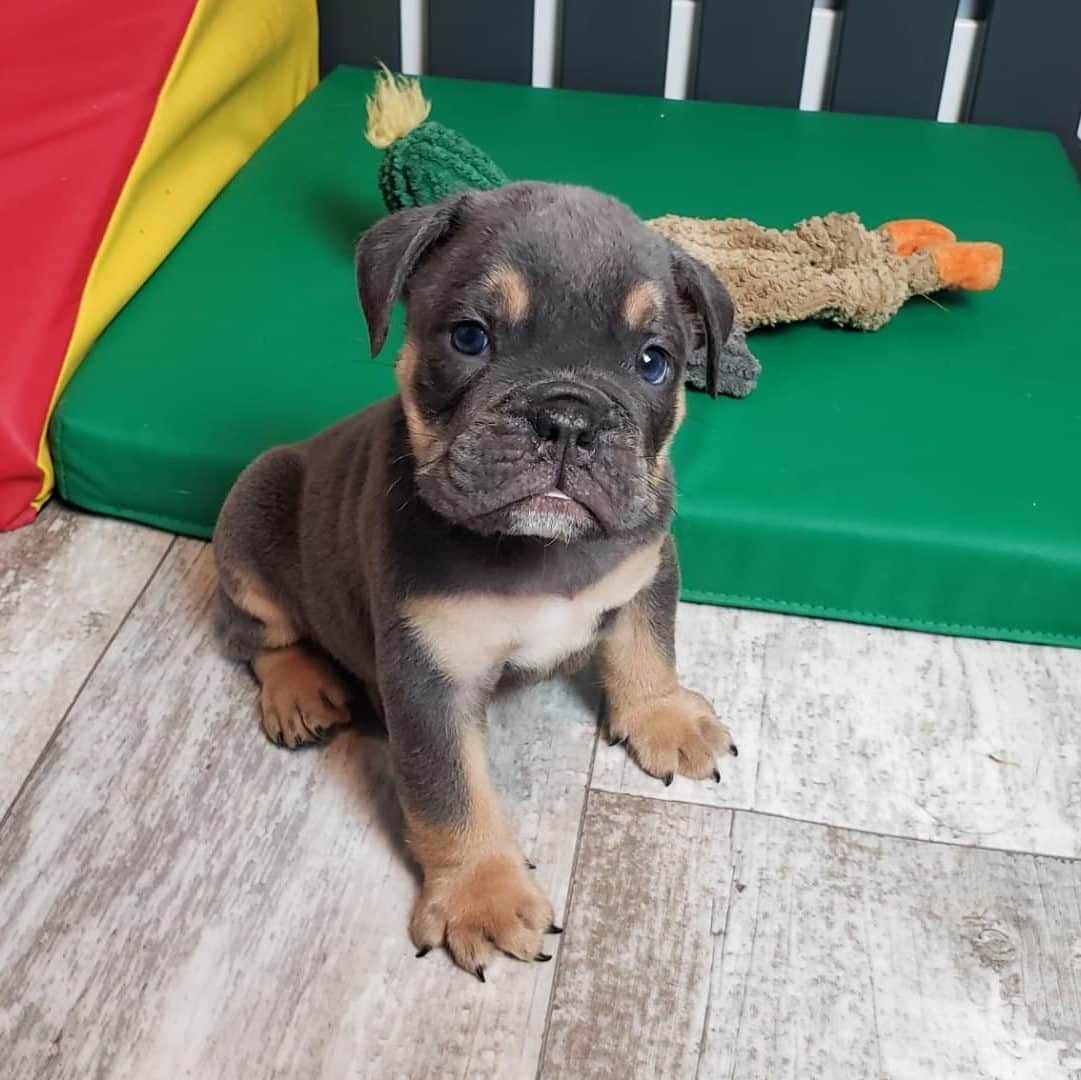
Example of a Blue English Bulldog Puppy
Blue Color Basics
Genotype for Blue Gene: [dd]
Blue English Bulldogs represent one of the four base rare colors. The others include: black, lilac and chocolate. It is commonly understood that Blue English Bulldogs are actually diluted black dogs. The black gene structure provides the the base color and then is diluted by the blue (dd) gene. We believe the blue coat should appear shiny and grey when placed against black objects or in the sun. If the Bulldog carries the Seal gene, the coat color should show maroon or other color undertones. A seal Bulldog may or may not have a fawn undercoat when the hair is rubbed backwards. It is important to remember that the nose, footpads, & eyeliner are always blue/grey, which can vary from light to dark, not to be mistaken for black.
Blue Tri Puppies
One of our favorite types of Blue English Bulldog Puppies for sale are the blue tri color. Black tri’s can be described as a color pattern where the tan points are typically on the eyebrows, cheeks, front shoulders (right above the chest area between the legs), around the tail, and partial on both front & back legs. Tan points will typically not show up if the bulldog carries white color patterns where the points would normally be. Tan points can also be hidden by other genes, such as the SEAL gene, as it is higher on the hierarchy of genes.
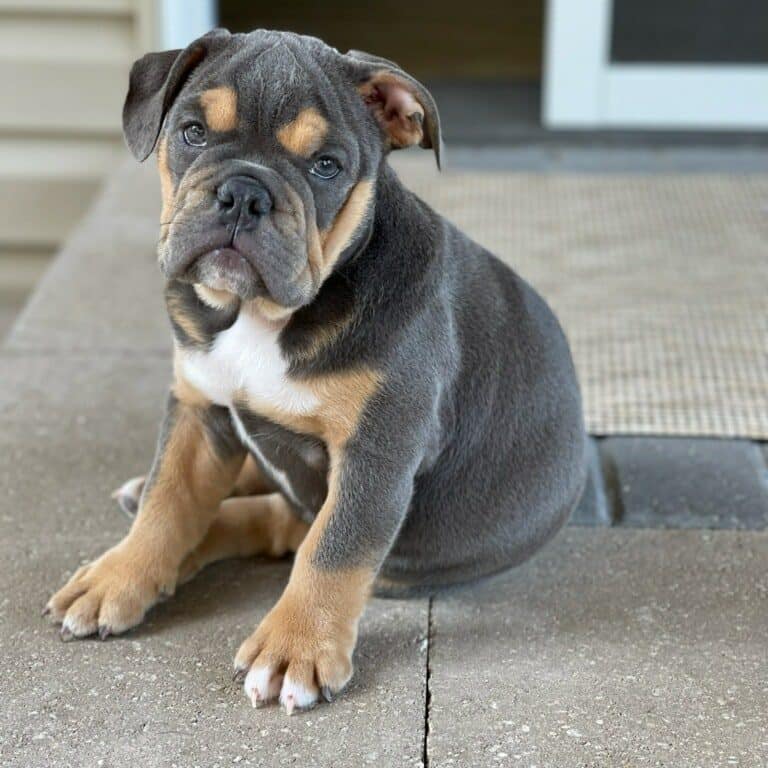
Example of a Blue Tri English Bulldog Puppy
Bruiser Bulldog’s take on Blue Coats
One rare occasions we will have a blue English Bulldog puppy. Because the blue coat is actually a dilute gene layered over black most often blue bulldog puppies are a product of intentional rare color breeding programs. Parents must be carriers of both the dilute blue and black genes. With this type of specificity, most blue colored bulldogs are not at all rare or an accident, but rather a product of intentional breeding programs. We are often extremely suspicious when rare colors become the main focus of a breeding program and a large volume producer of blue bulldogs is typically a huge red flag. In contrast, our Blue English Bulldogs are truly rare and unintentional. Our focus is always on health not on color. If you happen to love the blue color, let us know. You never know when we will have one.
Blue English Bulldog Color Guide – Click Here
Lilac Coat Color
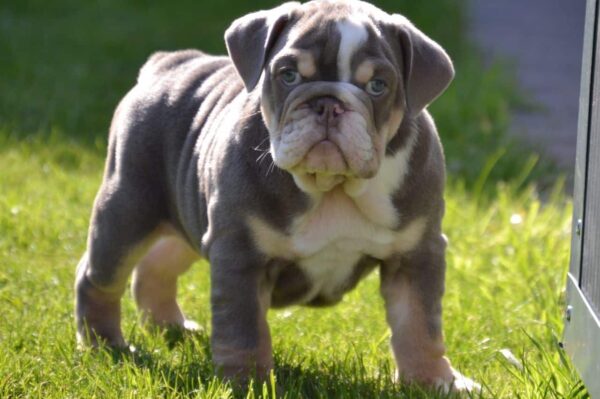
Example of a Lila English Bulldog Puppy
Lilac Color Basics
Genotype for Lilac Gene: [bb dd]
Lilac English Bulldogs represent one of the four base rare colors. The others include: black, blue, and chocolate. Similar to the blue coat (diluted once), Lilac Bulldogs build off the black gene and then are diluted two times. Black is diluted first by the chocolate gene and then the blue gene. Technically, the [bb] chocolate dilutes black color to brown and while [dd] blue dilutes the black to blue. In essence, Lilac is simply the mixing of brown and blue to achieve a purple or lilac hue. We believe the lilac coat should be shiny. It is also important to note that there are many lighter and darker shades possible with the variation of color combinations. The nose, eyeliner, and footpads are also always some shade of lilac or hue of purple.
Lilac Tri Puppies
To make the Lilac color even more complex, the Tri gene (tan points or eyebrows with tan accentuating the legs, underbody, and back end) can be added to the mix as well. A Tri Lilac Bulldog will carry the Tri, Black, Brown, and Blue genes together – a rare combination indeed. These type of bulldogs are what has spurred on both breeders and adopters to explore more color combinations (for better or worse).
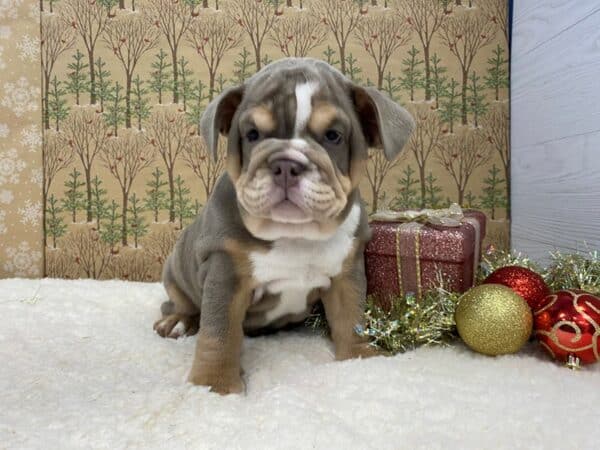
Example of a Lilac Tri English Bulldog Puppy
Bruiser Bulldog’s take on Lilac Coats
The Lilac color is super complex and almost impossible to produce without a specific breeding program devoted to it. We have produced only a handful of Lilac English Bulldog puppies in our entire breeding career. With the influx of rare colors, the possibility of the lilac color has certainly increased even within our breeding program, however it should still be considered super rare and certainly should not occupy a breeder’s focus. The lilac color is a fun surprise but should and should be incredibly rare if a breeder is focused on breeding first for health and personality as we do at Bruiser Bulldogs.
Lilac English Bulldog Color Guide Click Here
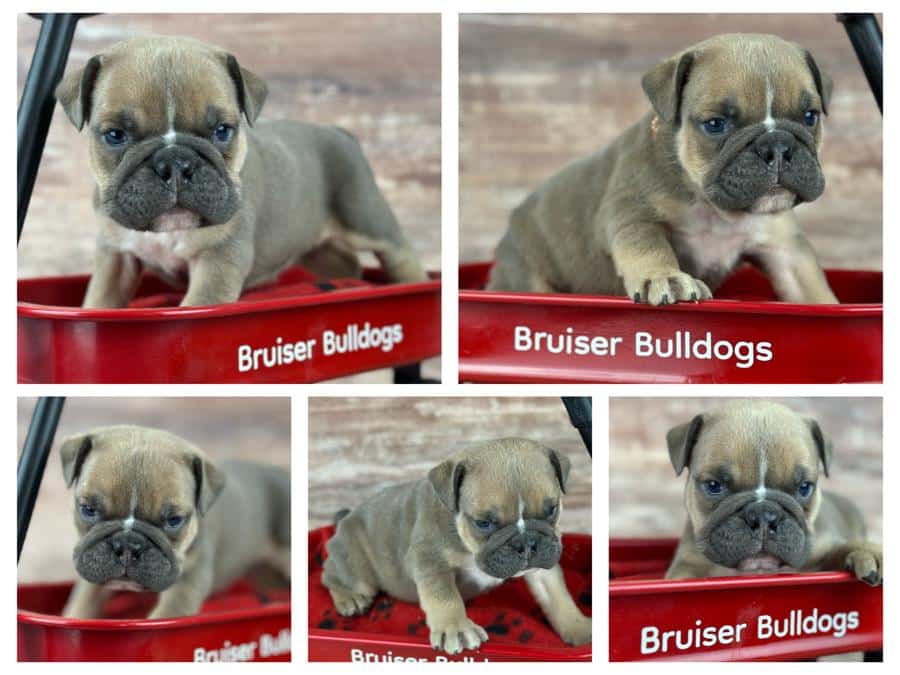
If you are interested in learning more about English Bulldog Coat Colors, please feel free to check out our comprehensive color guide! Click Here
Fawn English Bulldog Color Guide – Click Here
Red English Bulldog Color Guide – Click Here
Brindle English Bulldog Color Guide – Click Here
Check out our available puppies!
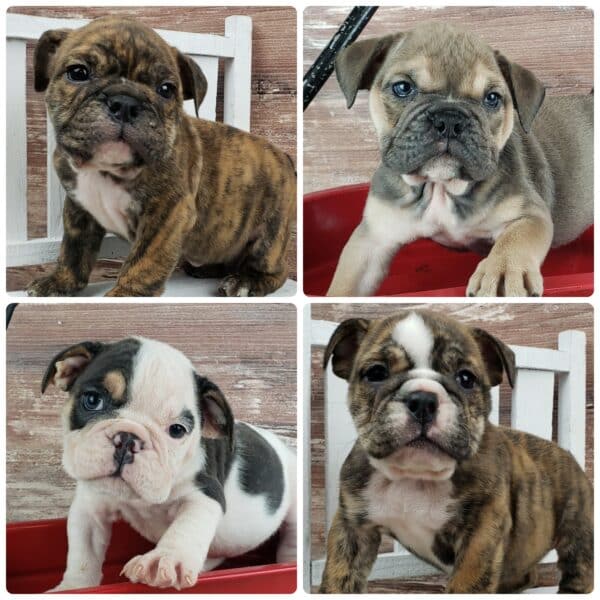
If you are interested in a English Bulldog Puppy and are looking for a breeder with experience and values improving the breed, Please reach out to us!
Greetings from the Wysongs!

Northern Indiana based, Bruiser Bulldogs offers purebred English Bulldog Puppies for sale to loving adopters seeking to find a higher quality English Bulldog. As English Bulldog breeders, Mitch and Erica Wysong have dedicated themselves to a lifelong journey of changing the culture and societal pressures of poor breeding practices within the English Bulldog Community.
Mitch and Erica believe in producing a healthy English Bulldog puppy first and foremost. Through years of research and development, Bruiser Bulldogs is leading a new movement away from the overdone, wrinkled bulldog that has been long plagued by health problems. By embracing a healthier, more athletic look they are able to ensure that each and every English Bulldog Puppy for sale by Bruiser Bulldogs is supported by a platform of health tested, clean genetics.
Upon adoption, each family that takes on the responsibility of a Bruiser Bulldog enters into an active and vibrant communal family of bulldog owners. Mitch and Erica believe it is their responsibility to provide emotional and mental support for the lifetime of each and every English Bulldog puppy they produce. To ensure the success of every adoption, Bruiser Bulldogs will always be committed to helping Bruiser Bulldog adopters care for their English Bulldogs to the best of their ability.
Bruiser Bulldog’s Reviews

If you are interested in learning more about our breeding philosophy you are welcome to visit the following pages:
What to look for in a bulldog breeder – Click Here
What is wrong with breeding solely for rare colors –Click Here
Selecting the correct English Bulldog for your family –Click Here









